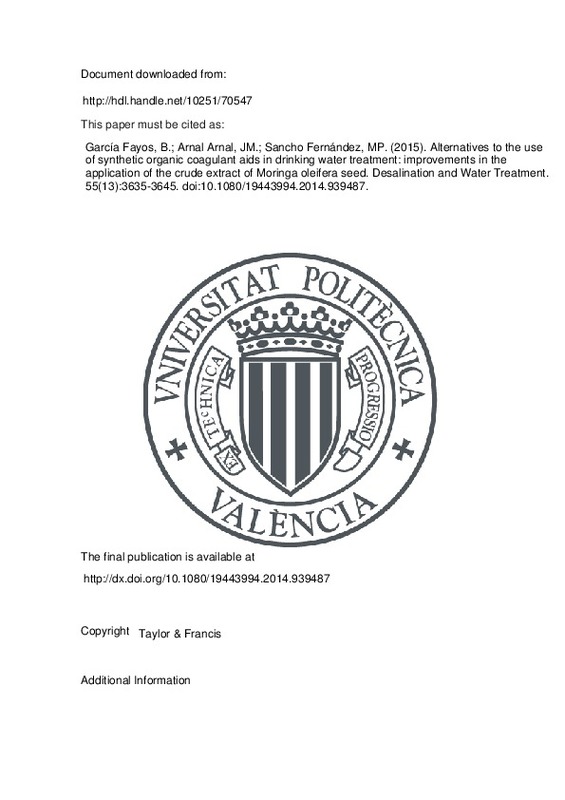Van Benschoten, J. E., & Edzwald, J. K. (1990). Chemical aspects of coagulation using aluminum salts—I. Hydrolytic reactions of alum and polyaluminum chloride. Water Research, 24(12), 1519-1526. doi:10.1016/0043-1354(90)90086-l
BOLTO, B. (1995). Soluble polymers in water purification. Progress in Polymer Science, 20(6), 987-1041. doi:10.1016/0079-6700(95)00010-d
Crapper, D. R., Krishnan, S. S., & Dalton, A. J. (1973). Brain Aluminum Distribution in Alzheimer’s Disease and Experimental Neurofibrillary Degeneration. Science, 180(4085), 511-513. doi:10.1126/science.180.4085.511
[+]
Van Benschoten, J. E., & Edzwald, J. K. (1990). Chemical aspects of coagulation using aluminum salts—I. Hydrolytic reactions of alum and polyaluminum chloride. Water Research, 24(12), 1519-1526. doi:10.1016/0043-1354(90)90086-l
BOLTO, B. (1995). Soluble polymers in water purification. Progress in Polymer Science, 20(6), 987-1041. doi:10.1016/0079-6700(95)00010-d
Crapper, D. R., Krishnan, S. S., & Dalton, A. J. (1973). Brain Aluminum Distribution in Alzheimer’s Disease and Experimental Neurofibrillary Degeneration. Science, 180(4085), 511-513. doi:10.1126/science.180.4085.511
Davison, A. M., Oli, H., Walker, G. S., & Lewins, A. M. (1982). WATER SUPPLY ALUMINIUM CONCENTRATION, DIALYSIS DEMENTIA, AND EFFECT OF REVERSE-OSMOSIS WATER TREATMENT. The Lancet, 320(8302), 785-787. doi:10.1016/s0140-6736(82)92678-2
Rondeau, V., Commenges, D., Jacqmin-Gadda, H., & Dartigues, J.-F. (2000). Relation between Aluminum Concentrations in Drinking Water and Alzheimer’s Disease: An 8-year Follow-up Study. American Journal of Epidemiology, 152(1), 59-66. doi:10.1093/aje/152.1.59
Rondeau, V. (2001). RE: ALUMINUM IN DRINKING WATER AND COGNITIVE DECLINE IN ELDERLY SUBJECTS: THE PAQUID COHORT. American Journal of Epidemiology, 154(3), 288-a-290. doi:10.1093/aje/154.3.288-a
Gauthier, E., Fortier, I., Courchesne, F., Pepin, P., Mortimer, J., & Gauvreau, D. (2000). Aluminum Forms in Drinking Water and Risk of Alzheimer’s Disease. Environmental Research, 84(3), 234-246. doi:10.1006/enrs.2000.4101
Kawamura, S. (1976). Considerations on Improving Flocculation. Journal - American Water Works Association, 68(6), 328-336. doi:10.1002/j.1551-8833.1976.tb02421.x
A.D. Faust, O.M. Aly, Chemistry of Water Treatment, Butterworths, Boston, MA, 1983, pp. 326–328.
Martenson, C. H., Sheetz, M. P., & Graham, D. G. (1995). In Vitro Acrylamide Exposure Alters Growth Cone Morphology. Toxicology and Applied Pharmacology, 131(1), 119-129. doi:10.1006/taap.1995.1053
Kaggwa, R. C., Mulalelo, C. I., Denny, P., & Okurut, T. O. (2001). The impact of alum discharges on a natural tropical wetland in uganda. Water Research, 35(3), 795-807. doi:10.1016/s0043-1354(00)00301-8
Dearfield, K. L., Abernathy, C. O., Ottley, M. S., Brantner, J. H., & Hayes, P. F. (1988). Acrylamide: its metabolism, developmental and reproductive effects, genotoxicity, and carcinogenicity. Mutation Research/Reviews in Genetic Toxicology, 195(1), 45-77. doi:10.1016/0165-1110(88)90015-2
McCollister, D. D., Oyen, F., & Rowe, V. K. (1964). Toxicology of acrylamide. Toxicology and Applied Pharmacology, 6(2), 172-181. doi:10.1016/0041-008x(64)90103-6
BOLTO, B., & GREGORY, J. (2007). Organic polyelectrolytes in water treatment. Water Research, 41(11), 2301-2324. doi:10.1016/j.watres.2007.03.012
World Health Organization, Guidelines for drinking-water quality: Incorporating first and second addenda, in: World Health Organization (Ed.) Recommendations, third ed., vol. 1, World Health Organization, Geneva, 2008, pp. 188–194.
Hamilton, M. A. (1994). A Statistician’s View of the U.S. Primary Drinking Water Regulation on Coliform Contamination. Environmental Science & Technology, 28(11), 1808-1811. doi:10.1021/es00060a009
J. Criddle, A review of the mammalian and aquatic toxicity of polyelectrolites, NR 2545 Medmenhan, Foundation for Water Research 1990.
Hebert, A., Forestier, D., Lenes, D., Benanou, D., Jacob, S., Arfi, C., … Levi, Y. (2010). Innovative method for prioritizing emerging disinfection by-products (DBPs) in drinking water on the basis of their potential impact on public health. Water Research, 44(10), 3147-3165. doi:10.1016/j.watres.2010.02.004
Gerecke, A. C., & Sedlak, D. L. (2003). Precursors ofN-Nitrosodimethylamine in Natural Waters. Environmental Science & Technology, 37(7), 1331-1336. doi:10.1021/es026070i
Charrois, J. W. A., Arend, M. W., Froese, K. L., & Hrudey, S. E. (2004). DetectingN-Nitrosamines in Drinking Water at Nanogram per Liter Levels Using Ammonia Positive Chemical Ionization. Environmental Science & Technology, 38(18), 4835-4841. doi:10.1021/es049846j
S.A.A. Jahn, Proper use of African natural coagulants for rural water supplies- Research in the Sudan and a guide for new projects, Deutsche Gesellschaft für Technische Zusammenarheit (GTZ), Eschborn, 1986.
Dorea, C. C. (2006). Use of Moringa spp. seeds for coagulation: a review of a sustainable option. Water Science and Technology: Water Supply, 6(1), 219-227. doi:10.2166/ws.2006.027
Kawamura, S. (1991). Effectiveness of Natural Polyelectrolytes in Water Treatment. Journal - American Water Works Association, 83(10), 88-91. doi:10.1002/j.1551-8833.1991.tb07236.x
Lee, S. H., Lee, S. O., Jang, K. L., & Lee, T. H. (1995). Microbial flocculant from Arcuadendron sp. TS-49. Biotechnology Letters, 17(1), 95-100. doi:10.1007/bf00134203
Effect of synthetic and natural coagulant on lignin removal from pulp and paper wastewater. (1997). Water Science and Technology, 35(2-3). doi:10.1016/s0273-1223(96)00943-2
Broekaert, W. F., Cammue, B. P. A., De Bolle, M. F. C., Thevissen, K., De Samblanx, G. W., Osborn, R. W., & Nielson, K. (1997). Antimicrobial Peptides from Plants. Critical Reviews in Plant Sciences, 16(3), 297-323. doi:10.1080/07352689709701952
Jahn, S. A. A. (1988). Using Moringa
Seeds as Coagulants in Developing Countries. Journal - American Water Works Association, 80(6), 43-50. doi:10.1002/j.1551-8833.1988.tb03052.x
Muyibi, S. A., & Okuofu, C. A. (1995). Coagulation of low turbidity surface waters withMoringa oleiferaseeds. International Journal of Environmental Studies, 48(3-4), 263-273. doi:10.1080/00207239508710996
Ndabigengesere, A., Narasiah, K. S., & Talbot, B. G. (1995). Active agents and mechanism of coagulation of turbid waters using Moringa oleifera. Water Research, 29(2), 703-710. doi:10.1016/0043-1354(94)00161-y
Okuda, T., Baes, A. U., Nishijima, W., & Okada, M. (2001). Isolation and characterization of coagulant extracted from moringa oleifera seed by salt solution. Water Research, 35(2), 405-410. doi:10.1016/s0043-1354(00)00290-6
Ghebremichael, K. A., Gunaratna, K. R., Henriksson, H., Brumer, H., & Dalhammar, G. (2005). A simple purification and activity assay of the coagulant protein from Moringa oleifera seed. Water Research, 39(11), 2338-2344. doi:10.1016/j.watres.2005.04.012
Sánchez-Martín, J., Ghebremichael, K., & Beltrán-Heredia, J. (2010). Comparison of single-step and two-step purified coagulants from Moringa oleifera seed for turbidity and DOC removal. Bioresource Technology, 101(15), 6259-6261. doi:10.1016/j.biortech.2010.02.072
[-]







![[Cerrado]](/themes/UPV/images/candado.png)


